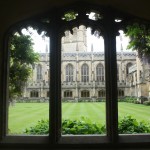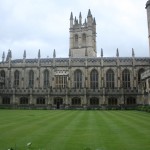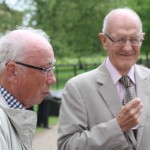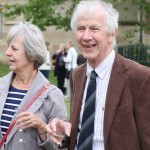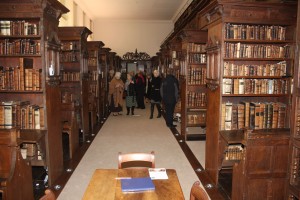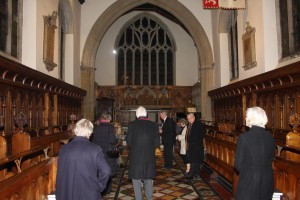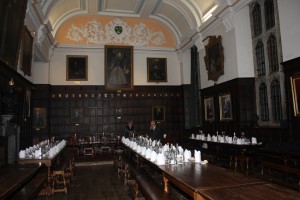Volunteers Coffee Morning, 4 July, 2013
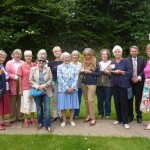 A coffee morning was held for all the kind people who arrive early for each lecture and help with serving coffee and signing members in. As they are therefore unable to chat to everyone, this was an opportunity for them to get to know each other a little better as well as a small ‘thank you’. We were blessed with good weather and so were able to wander in the garden.
A coffee morning was held for all the kind people who arrive early for each lecture and help with serving coffee and signing members in. As they are therefore unable to chat to everyone, this was an opportunity for them to get to know each other a little better as well as a small ‘thank you’. We were blessed with good weather and so were able to wander in the garden.
12th June 2013, Lecture and Drinks
Our lecture year ended on a high note with a first rate and inspirational lecture from Timothy Wilson, Curator of the Ashmolean Western Art acquisitions. The lecture was followed by an end of year drinks reception which gave members a chance to mix and enjoy a pleasant stroll around the Magdalen College gardens. These photo’s taken by Peter Vezey show something of the splendour of the college grounds and buildings.
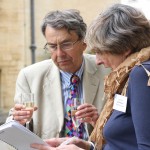
Membership secretary Judith Brown and Treasurer, Allan Taylor deep in conference, helped by a drink or two!
Oxford DFAS in St Petersburg May 2013
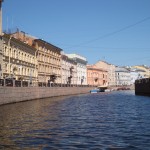 Twenty nine of us flew north out of cold England and arrived in sunny St Petersburg where for the next six days the temperature climbed up to the mid 20s with just the occasional shower. We were greeted by Elena, our wonderful Russian guide, whose patience and stamina with our large and independent-minded group was boundless. She was assisted on occasion by her art critic husband Sergei, from whose deep knowledge of Russian culture and art we all benefited.
Twenty nine of us flew north out of cold England and arrived in sunny St Petersburg where for the next six days the temperature climbed up to the mid 20s with just the occasional shower. We were greeted by Elena, our wonderful Russian guide, whose patience and stamina with our large and independent-minded group was boundless. She was assisted on occasion by her art critic husband Sergei, from whose deep knowledge of Russian culture and art we all benefited. 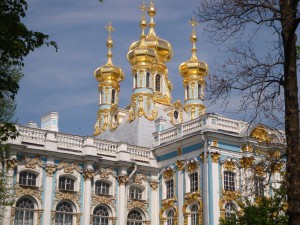 Our packed itinerary began with a visit to the Peterhof palace, which Peter the Great had modelled on Versailles. This was our first experience of the extravagant opulence of the Romanov Tsars’ taste, with room after room decorated with apparently limitless amounts of gold leaf, sumptuous chandeliers and mirrors, and with beautiful marquetry on the wooden floors. It also gave us alas firsthand experience of pick pocketing which made us all very wary thereafter. The park, which led down to the Gulf of Finland, was just as grand and filled with a glorious display of fountains and canals (and more palaces!). On other days we also visited the two other major imperial summer palaces outside the city – Pavlosk and Tsarskoye Selo, the former designed (by Charles Cameron, a Scottish architect) in a more restrained classical style, with a less formal park more reminiscent of Blenheim or Stowe than Versailles. The town palace of Prince Yusupov was another highlight, the site of the notorious assassination of Rasputin in 1916 (artfully reconstructed for visitors).
Our packed itinerary began with a visit to the Peterhof palace, which Peter the Great had modelled on Versailles. This was our first experience of the extravagant opulence of the Romanov Tsars’ taste, with room after room decorated with apparently limitless amounts of gold leaf, sumptuous chandeliers and mirrors, and with beautiful marquetry on the wooden floors. It also gave us alas firsthand experience of pick pocketing which made us all very wary thereafter. The park, which led down to the Gulf of Finland, was just as grand and filled with a glorious display of fountains and canals (and more palaces!). On other days we also visited the two other major imperial summer palaces outside the city – Pavlosk and Tsarskoye Selo, the former designed (by Charles Cameron, a Scottish architect) in a more restrained classical style, with a less formal park more reminiscent of Blenheim or Stowe than Versailles. The town palace of Prince Yusupov was another highlight, the site of the notorious assassination of Rasputin in 1916 (artfully reconstructed for visitors). 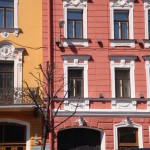 What impressed in all that we saw was the meticulous and lavish restoration of these Tsarist buildings by a communist regime. Many of them had been all but destroyed during WWII, and the care and skill (and enormous expense) of the restoration was telling evidence of the Russian reverence for their history culture and St Petersburg’s place in it.
What impressed in all that we saw was the meticulous and lavish restoration of these Tsarist buildings by a communist regime. Many of them had been all but destroyed during WWII, and the care and skill (and enormous expense) of the restoration was telling evidence of the Russian reverence for their history culture and St Petersburg’s place in it.  A boat ride in glorious sunshine on the canals which lead off the River Neva and interlace the city, and a full day visit to the mediaeval capital of Novgorod, a glimpse of the real Russia with its Byzantine style cathedral and monastery buildings enclosed in an ancient (but again restored) Kremlin and containing original wall paintings and icons, were more delights. En route through the countryside to Novgorod, we saw a more genuine side of Russian life; a flat landscape with traditional wooden dachas scattered among endless silver birch and fir forests. Our excellent driver, Pasha, gave us a calm passage everywhere, and also performed miracles on a damaged radiator which might have sabotaged the trip at the outset.
A boat ride in glorious sunshine on the canals which lead off the River Neva and interlace the city, and a full day visit to the mediaeval capital of Novgorod, a glimpse of the real Russia with its Byzantine style cathedral and monastery buildings enclosed in an ancient (but again restored) Kremlin and containing original wall paintings and icons, were more delights. En route through the countryside to Novgorod, we saw a more genuine side of Russian life; a flat landscape with traditional wooden dachas scattered among endless silver birch and fir forests. Our excellent driver, Pasha, gave us a calm passage everywhere, and also performed miracles on a damaged radiator which might have sabotaged the trip at the outset. 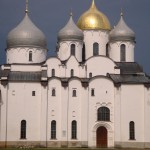 But of course the central focus of any visit to St Petersburg has to be wondrous collections in the Winter Palace and the Hermitage galleries, begun by Catherine the Great who for several decades acquired relentlessly and laid the foundation, built on by her successors, for what must be the richest display of renaissance and post-renaissance art anywhere in the world. Unforgettable works by masters from many schools – Leonardo, Raphael, Giorgione, Titian, Rembrandt, Rubens, Cranach, Poussin, Watteau, Velasquez, Murillo, Goya, Van Dyck, Gainsborough and Reynolds to name just some of the artists represented , often by many works. Supplementing the imperial collections are the stunning impressionist and post-impressionist masterpieces confiscated from private collections after the revolution, with especially strong representation of Matisse, Gauguin and Picasso. And that was just the paintings – no time for the ceramics, jewellery or the Scythian gold! We had one day and could have spent many more. Our itinerary also took in the Russian Museum which contained the whole range of Russian art from 12th century icons up to Kandinsky, Goncharova, Malevich and beyond. It wasn’t all art, of course. We sampled some indifferent, and some tasty, Russian cuisine, culminating in a delightful last lunch in a rustic restaurant on the way to the airport, according to Elena much patronised by President Putin when in town, and clearly by other notables too, if the large black cars outside with their accompanying muscle were any indication. The trip also provided a range of musical experiences. Every place we visited seemed to sport a group of a capella singers with lovely deep Russian voices and a little sales pitch afterwards for their CDs. In addition some of us went to the ballet, some to the opera, some to a Russian folk night incorporating more singing and wild Cossack dancing, and some to listen to a fabulous Russian choir from the Urals. Many thanks to Polly Woolstone and Josephine Willmott for making this trip possible and being such equable marshalls. What an experience. Whither next?
But of course the central focus of any visit to St Petersburg has to be wondrous collections in the Winter Palace and the Hermitage galleries, begun by Catherine the Great who for several decades acquired relentlessly and laid the foundation, built on by her successors, for what must be the richest display of renaissance and post-renaissance art anywhere in the world. Unforgettable works by masters from many schools – Leonardo, Raphael, Giorgione, Titian, Rembrandt, Rubens, Cranach, Poussin, Watteau, Velasquez, Murillo, Goya, Van Dyck, Gainsborough and Reynolds to name just some of the artists represented , often by many works. Supplementing the imperial collections are the stunning impressionist and post-impressionist masterpieces confiscated from private collections after the revolution, with especially strong representation of Matisse, Gauguin and Picasso. And that was just the paintings – no time for the ceramics, jewellery or the Scythian gold! We had one day and could have spent many more. Our itinerary also took in the Russian Museum which contained the whole range of Russian art from 12th century icons up to Kandinsky, Goncharova, Malevich and beyond. It wasn’t all art, of course. We sampled some indifferent, and some tasty, Russian cuisine, culminating in a delightful last lunch in a rustic restaurant on the way to the airport, according to Elena much patronised by President Putin when in town, and clearly by other notables too, if the large black cars outside with their accompanying muscle were any indication. The trip also provided a range of musical experiences. Every place we visited seemed to sport a group of a capella singers with lovely deep Russian voices and a little sales pitch afterwards for their CDs. In addition some of us went to the ballet, some to the opera, some to a Russian folk night incorporating more singing and wild Cossack dancing, and some to listen to a fabulous Russian choir from the Urals. Many thanks to Polly Woolstone and Josephine Willmott for making this trip possible and being such equable marshalls. What an experience. Whither next?
Chiswick and Syon Houses and Gardens, 24 April 2013
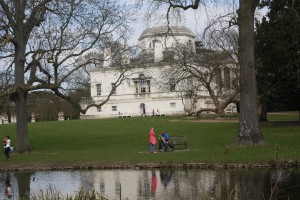 Over thirty members and guests of Oxford NADFAS group enjoyed one of the first days of spring with a visit to two famous premises at Chiswick. The first, Chiswick House, was built in 1720 by Lord Burlington not as a normal house with kitchens and bedrooms but a place for entertaining his many friends and for showing off his diverse collections including some excellent examples of the old masters’ paintings. It was extended with two wings, which were later removed to give way to a new building with full living accommodation. More recently the premises were meticulously renovated by English Heritage. Both the interior and gardens of this ‘edge of London’ retreat were designed by William Kent. The home and gardens have a considerable Italian design influence. The former Italian gardens, the wilderness walk and the 300 foot conservatory which were added by later owners, have recently been restored to their former glory.
Over thirty members and guests of Oxford NADFAS group enjoyed one of the first days of spring with a visit to two famous premises at Chiswick. The first, Chiswick House, was built in 1720 by Lord Burlington not as a normal house with kitchens and bedrooms but a place for entertaining his many friends and for showing off his diverse collections including some excellent examples of the old masters’ paintings. It was extended with two wings, which were later removed to give way to a new building with full living accommodation. More recently the premises were meticulously renovated by English Heritage. Both the interior and gardens of this ‘edge of London’ retreat were designed by William Kent. The home and gardens have a considerable Italian design influence. The former Italian gardens, the wilderness walk and the 300 foot conservatory which were added by later owners, have recently been restored to their former glory.  Possibly more famous, Syon House was the afternoon visit where, like at Chiswick House, the NADFAS visitors were given a guided tour by one of the excellent volunteer historians. Syon House and its 200 acre park, home to the Dukes of Northumberland for 400 years is a castellated mid-16th century house built on the site of a dissolved Medieval monastery. The building contains five sumptuously refurbished rooms by Robert Adam, in neo-classical style which are considered by the experts to be Adams’ early English masterpiece.
Possibly more famous, Syon House was the afternoon visit where, like at Chiswick House, the NADFAS visitors were given a guided tour by one of the excellent volunteer historians. Syon House and its 200 acre park, home to the Dukes of Northumberland for 400 years is a castellated mid-16th century house built on the site of a dissolved Medieval monastery. The building contains five sumptuously refurbished rooms by Robert Adam, in neo-classical style which are considered by the experts to be Adams’ early English masterpiece. 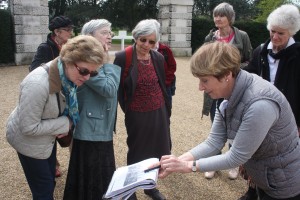 The extensive gardens which were laid out by Capability Brown, contain a renowned collection of rare plants and trees. The Great Conservatory built in 1826 containing a wide range of plants, is believed to be the inspiration for the design of the Crystal Palace in South London.
The extensive gardens which were laid out by Capability Brown, contain a renowned collection of rare plants and trees. The Great Conservatory built in 1826 containing a wide range of plants, is believed to be the inspiration for the design of the Crystal Palace in South London.
Heraldry: It’s All Around Us – An Introduction to Everyday Heraldry, 10 April 2013
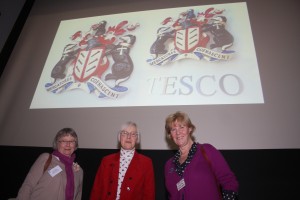 Anyone who likes puzzles and codes would have enjoyed this lecture. I was unfamiliar with the ideas of heraldry so learnt a lot of new terminology: gules for red, vair for squirrel. We learnt how to unpick a coat of arms – a dragon means a Welsh connection, a unicorn for Scotland. Of course the English coat of arms was constantly reconfigured to reflect the changes in the monarchy: George I introduced the white horse of Hanover, but Victoria could not succeed to the throne of Hanover so had to relinquish the Hanoverian symbols. Our speaker had done her local research, and our memories were tested as we tried to recall where these all too familiar coats of arms were to be found in Oxford. Baroness Thatcher, who had died two days earlier, provided us with a good example of how to create a coat of arms. And none of us will be able to look at a Tesco’s bag again without thinking of our heraldry lecture.
Anyone who likes puzzles and codes would have enjoyed this lecture. I was unfamiliar with the ideas of heraldry so learnt a lot of new terminology: gules for red, vair for squirrel. We learnt how to unpick a coat of arms – a dragon means a Welsh connection, a unicorn for Scotland. Of course the English coat of arms was constantly reconfigured to reflect the changes in the monarchy: George I introduced the white horse of Hanover, but Victoria could not succeed to the throne of Hanover so had to relinquish the Hanoverian symbols. Our speaker had done her local research, and our memories were tested as we tried to recall where these all too familiar coats of arms were to be found in Oxford. Baroness Thatcher, who had died two days earlier, provided us with a good example of how to create a coat of arms. And none of us will be able to look at a Tesco’s bag again without thinking of our heraldry lecture.
Oxford DFAS dinner – 20 March 2013
When the idea of holding an inaugural Oxford DFAS dinner in one of Oxford’s historic colleges was first conceived back in the autumn of 2012 and the date and college was decided for 20 March 2013, we envisaged the backdrop of a pleasant early spring evening with sunlight dappling the limestone walls of Jesus College to set off our programme of a lecture on Stained Glass Conservation from York Glazier’s Trust Director and expert Sarah Brown followed by a drinks reception, tours of the college and a three course dinner. We now know that March 2013 is being considered as the coldest March for fifty years and Wednesday the 20th of the month was no exception to the rule. It was of course bitterly cold that evening and instead of light wraps and cardigans, the dress code was definitely for comfort and warmth. But the wintry conditions outside did nothing to mar the enjoyment of the evening, stalwarts that the members of Oxford DFAS are. Sixty eight of us were present to hear Sarah Brown, who had travelled down from York that afternoon, give a first class lecture in the excellent new Jesus College auditorium on Stained Glass conservation. Using a wide range of images, Sarah took the audience through the history of English stained glass and the different techniques used over the centuries to repair and conserve it. For those of us already interested in Stained Glass as a decorative and cultural art form our knowledge was deepened and for those who had not had much interest or knowledge prior to the lecture, they found that their interest had been aroused.
Following the lecture, everyone repaired, in their warm winter coats, to the Principal’s Drawing Room for a glass of sparkling wine and then visited the 16th century Chapel and 17th century Old Library. As we criss crossed quads to go from chapel to Old Library in the atmosphere of near freezing temperatures and the darkness of the night, it was easy to imagine what it must have been like to live in a college in those early centuries before the comfort of modern heating and lighting.
Dinner was held in the 17th century Hall. We were surrounded by history – portraits of Queen Elizabeth 1, co–founder in 1571 of the college with Hugh ap Price, Treasurer of St David’s Cathedral, Kings Charles First and Second, T E Lawrence, Harold Wilson and several benefactors – as we enjoyed a wonderful meal of Pear and Roquefort Tart, Roasted Breast of Duck and Fruit Cranachan with Shortbread biscuit prepared by Deborah Kelly Greaves, the head chef and her staff. Kate Lack, chairman March 2013.

